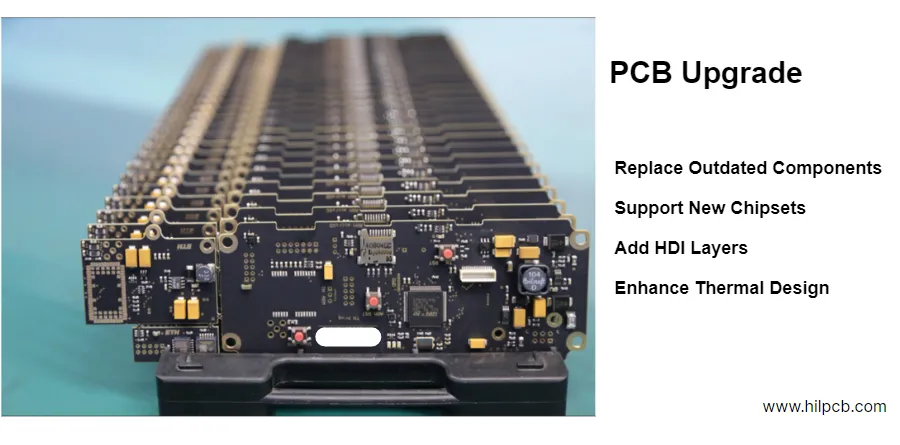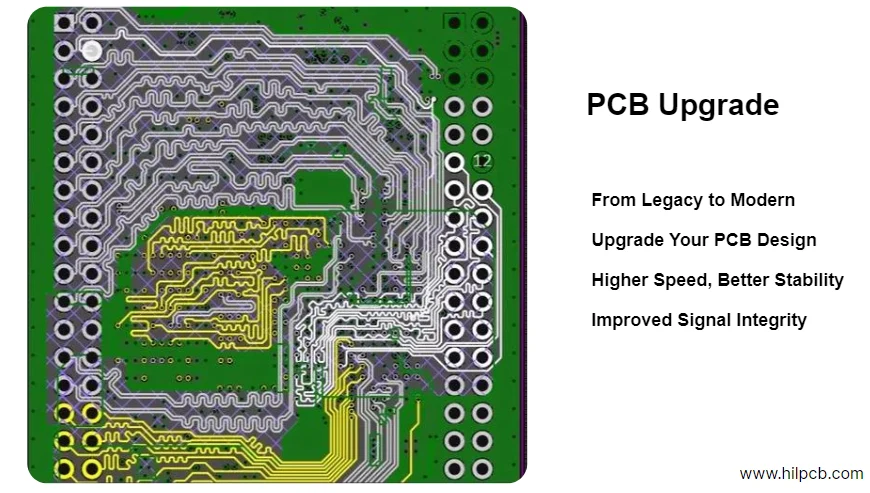The Reality: That 2008-era industrial controller still works, but replacement components cost 10x original price—if you can find them. The 8-bit processor struggles with modern protocols. The linear power supply wastes 70% of input power as heat.
The Opportunity: Modern PCB upgrade technology delivers 10x processing power in 1/3 the space while cutting BOM costs by 50%. We regularly transform 15-year-old designs into competitive products using current components and manufacturing techniques.
Case Study: Upgraded a 2009 data acquisition board from 8051 processor to ARM Cortex-M4. Results: 100MHz vs 12MHz processing, $47 vs $142 BOM cost, 85% vs 45% power efficiency, added WiFi/Bluetooth at no extra cost.
Technology Migrations That Transform Legacy PCBs
Processor Architecture Upgrades
From 8/16-bit to 32-bit ARM: Old 8051, PIC16, or AVR designs migrate seamlessly to modern Cortex-M processors. Same footprint options available. Integrated peripherals eliminate 20+ external components. Power consumption drops 60-80% in active mode, 95% in sleep mode.
Migration example (real customer data):
- Original: ATmega328 + external ADC + EEPROM + crystal
- Upgraded: STM32G0 with integrated 12-bit ADC, 32KB flash, internal oscillator
- Results: $8.50 → $2.30 BOM, 6 components → 1 component, 28-pin → 20-pin package
From DSP to Modern SoC: Legacy DSP boards using TMS320 series upgrade to integrated solutions. Modern SoCs combine DSP, ARM, and FPGA resources. Single chip replaces entire board in many applications.
Power System Modernization
Linear to Switching Conversion:
| Aspect | Linear Regulator (2010) | Modern Switching (2025) | Improvement |
|---|---|---|---|
| Efficiency | 35-50% | 92-96% | 2.5x better |
| Heat Generation | 5-10W waste heat | 0.3-0.8W | 90% reduction |
| Size | TO-220 + heatsink | 3x3mm QFN | 85% smaller |
| Cost | $3-5 + heatsink | $0.80-1.50 | 70% cheaper |
| Features | Basic regulation | PFM/PWM, UVLO, OCP | Smart protection |
Multi-Rail Consolidation: Legacy boards with 5+ power supplies consolidate to single PMIC. Integrated sequencing eliminates discrete supervisors. Digital control enables field optimization.
Connectivity Evolution
Old designs with RS-232/485 get modern wireless capabilities:
- Bluetooth 5.3: 2Mbps data rate, 1km range, mesh networking
- WiFi 6: Gigabit speeds, WPA3 security, cloud connectivity
- LoRaWAN: 10km range, 10-year battery life
- 5G/LTE-M: Global coverage, 10Mbps, integrated GPS
Real implementation: Industrial sensor board upgraded from RS-485 to dual WiFi/BLE. Cost increase: $3.50. Value add: Remote monitoring, OTA updates, smartphone apps, cloud analytics.

The PCB Upgrade Process: Week-by-Week Breakdown
Week 1: Legacy Analysis & Planning
- Reverse-engineer existing design if files unavailable
- Identify obsolete components and modern replacements
- Define upgrade objectives and constraints
- Create technology migration roadmap
Week 2-3: Schematic Redesign
- Implement processor migration with peripheral mapping
- Consolidate discrete components into integrated solutions
- Add modern interfaces and connectivity
- Maintain backward compatibility where required
Week 4-5: Layout Optimization
- Reduce layer count through HDI technology
- Implement controlled impedance for high-speed signals
- Optimize thermal management with copper pours
- Shrink form factor while improving manufacturability
Week 6-7: Prototype & Validation
- Fabricate first articles with expedited service
- Validate electrical performance against original
- Verify software compatibility and migration
- Conduct thermal and EMC pre-compliance testing
Week 8: Production Preparation
- Finalize BOM with multi-source components
- Generate complete manufacturing package
- Create migration guide for existing customers
- Establish volume production timeline
ROI Calculation for Legacy PCB Upgrades
Typical 1000-Unit Annual Production ROI
Cost Savings:
- Component cost reduction: $75/board × 1000 = $75,000/year
- Assembly time reduction (50%): $12/board × 1000 = $12,000/year
- Reduced failures (80% lower): $8,000/year warranty = $6,400/year
- Inventory reduction (fewer parts): $15,000 one-time
Investment Required:
- Engineering upgrade service: $12,000-18,000
- Prototype and validation: $3,000-5,000
- Certification updates: $5,000-8,000
Payback Period: 2.5-4 months 3-Year Net Savings: $250,000+
Component Obsolescence Solutions in PCB Upgrades
Proactive Replacement Strategy: We don't just swap parts—we future-proof designs:
- Select components with 10+ year lifecycles
- Implement multi-source compatible footprints
- Use automotive/industrial grade parts for longevity
- Design in programmable components for flexibility
Common Obsolete Component Upgrades:
- MAX232 → Integrated USB: Eliminate RS-232 transceivers
- Parallel Flash → QSPI Flash: 50x faster, 1/4 the pins
- Linear Optocouplers → Digital Isolators: 10x faster, 80% smaller
- Discrete Logic → CPLD/FPGA: Hundreds of gates in single chip
- Analog Multiplexers → MCU with Multiple ADCs: Reduce component count by 90%

Industry-Specific PCB Upgrade Applications
Industrial Control Systems
- PLC boards from 1990s-2000s upgraded with IoT capabilities
- Add predictive maintenance features to existing controllers
- Integrate cybersecurity features into legacy systems
- Typical result: 60% cost reduction, 10x processing power
Medical Equipment
- Upgrade life-support equipment with obsolete processors
- Add wireless connectivity for remote monitoring
- Improve power efficiency for portable devices
- Maintain FDA 510(k) compliance through careful documentation
Telecommunications Infrastructure
- Convert TDM systems to packet-switched architectures
- Upgrade backhaul radios from 3G to 5G technology
- Increase channel density by 4-8x in same form factor
- Reduce power consumption by 70% per channel
Test & Measurement
- Upgrade 8-bit ADCs to 24-bit for higher precision
- Add USB/Ethernet to GPIB-only instruments
- Increase sampling rates from MHz to GHz
- Integrate display and UI into single board
For surgical fixes to existing designs, see our PCB modification services. When starting fresh makes sense, explore PCB redesign options. For expert guidance, schedule a PCB consultation with our engineering team.
Frequently Asked Questions
Q: Can we upgrade without losing safety certifications? A: Yes. We document all changes per IEC 60601 (medical) and IEC 61508 (industrial) standards. Minor component upgrades typically qualify as "equivalent replacement" maintaining existing certifications.
Q: What if our product uses custom ASICs? A: We've successfully replaced obsolete ASICs with FPGA implementations. Modern FPGAs can duplicate most ASIC functions at competitive costs for volumes under 10,000 units.
Q: How do you handle mechanical constraints? A: PCB upgrades maintain identical mechanical interfaces. Connectors, mounting holes, and enclosure compatibility are preserved unless specifically requested otherwise.
Q: Can upgraded boards run existing firmware? A: We provide hardware abstraction layers (HAL) to maintain software compatibility. Most customers run existing code with minimal modifications.
Q: What's the minimum quantity for upgrade projects? A: We handle upgrades from prototype quantities to 100K+ annual volumes. NRE amortizes quickly even at 100-unit annual quantities given the cost savings.

![Legacy PCB Upgrade: Migrate 10+ Year Old Designs to Modern Technology [2025 Guide]](/assets/img/blogs/pcb-upgrade.webp)